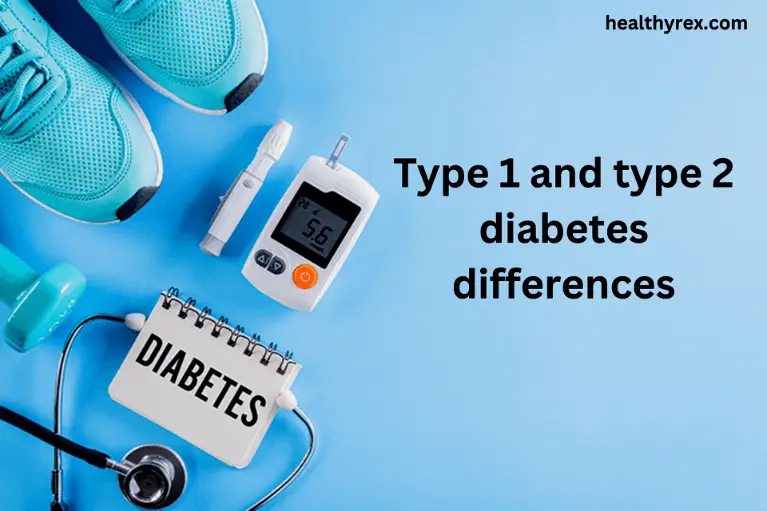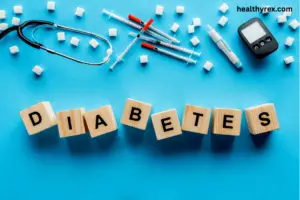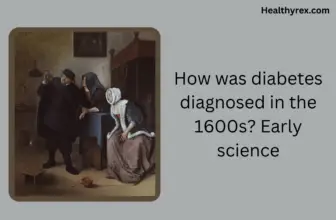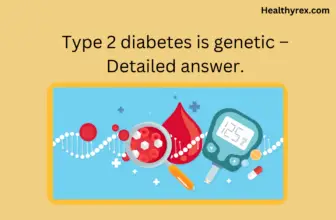Type 1 and Type 2 Diabetes Differences

Though both type 1 and 2 diabetes have some things in common, there are still several differences. Like their causes, their way of affecting the body, and most importantly, their treatment. Type 1 affects around 8% of people with diabetes, whereas type 2 diabetes affects the remaining 90%.
The most vital type 1 and type 2 diabetes difference is that type 1 is a genetic disease, while type 2 relates to your lifestyle. Type 1 diabetes appears in the early stage of life, while type 2 develops with time. In type 1 diabetes, your immune system, by mistake, attacks the insulin cells of the pancreas and destroys them.
People often get confused between type 1 and type 2 diabetes. It means that you have to clear them that they are two different types, and if one thing is working for type 1 doesn’t mean it will work for type 2.
The main thing is that both are severe conditions that you can’t neglect. High blood sugar levels can lead to serious health complications in both types. So if you have any of them, consult a specialist to know what you should do.
Type 1 and Type 2 Diabetes Difference

Here are the details of type 1 and type 2 diabetes differences:
Type 1 Diabetes:
Type 1 diabetes is a condition in which one’s immune system accidentally destroys the insulin-making cells in the pancreas. These cells are known as beta cells. It is generally diagnosed in young people, especially children, so it is famous as juvenile diabetes.
Secondary diabetes is similar to type 1diabetes, but the main difference is that your beta cells wipe out by something else. It can be an injury to the pancreas or maybe a disease. Both of these differ from diabetes, in which the body doesn’t respond to insulin as it should.
Symptoms:
Type 1 diabetes symptoms can appear at any time, and they mainly include:
- Frequent urination
- Feeling weak and tired
- Increase in thirst
- Blurry vision
- Feeling irritated or having other mood changes
- The wetting bed is seen in children who have never done this before
- Sudden mood changes and feeling irritated
- Unintentional weight loss
Causes:
The exact cause of type 1 diabetes is not clear. But according to the research, the body’s immune system, which protects it from the harmful virus and bacteria, starts destroying the healthy insulin-producing cells in the pancreas. Some other possible causes include:
- Viral exposure
- Genetics
- Environmental factors
The Role of Insulin:
The body will stop producing insulin when the immune system destroys the maximum healthy islet cells. Insulin is a hormone from a gland below and behind the pancreas.
- The pancreas puts the insulin back into the bloodstream
- Insulin allows the sugar to enter the cell by traveling around the body
- Insulin lowers the blood sugar in our bloodstream
- When the blood glucose starts to fall, it lowers the levels
The Role of Glucose:
Glucose is the primary source of energy for the cells that makes the tissues and muscles.
- Glucose is a sugar that is a primary energy source for the cells. It also benefits the making up of the tissues and even muscles.
- Our liver stores the extra glucose in the glycogen form
- The bloodstream absorbs the sugar and starts entering the cells with insulin’s help.
- When the glucose level gets low, it means when we don’t eat, and our liver starts the breakdown of glycogen to glucose. It keeps the glucose level at the healthy range.
In type 1 diabetes, there is no insulin in our body to let the glucose in our cells. Its leads to the build-up of sugar in our bloodstream. If not get treated, it can result in life-threatening complications.
Risk Factors:
Some factors can raise the risk of getting type 1 diabetes, and they include:
- Genetics
The specific genes can increase the chances of getting type 1 diabetes.
- Family History
If your family or siblings have type 1 diabetes, you will be more at risk of getting it than the others.
- Age
Type 1 diabetes can appear at any stage, but mostly it seems at two prominent peaks. The first one is in children who are between 4 to 7 years old. The second is in children of 10 to 14 years of age.
- Geography
The number of people with type 1 diabetes will be higher when you travel away from the equator.
Prevention:
There is no possible way of type 1 diabetes prevention. But researchers are working hard to find a way to stop the destruction of the islet cells and stop the further damage in the new ones. You can consult your medical practitioner if eligible for these clinical trials. Getting complete information about the benefits and risks is vital before going for such treatment plans.
Type 2 Diabetes:
Type 2 diabetes is a lifelong disease that keeps your body from properly using insulin. Type 2 diabetes patients have insulin resistance. Middle-aged and older people are at high risk of getting this disease. But this type also affects teens, kids, and especially children with childhood obesity.
Type 2 diabetes is prevalent; about 90% of diabetic patients have type 2 diabetes. Thereare29 million people in the US who have type 2, and about 84 million whose blood sugar level is high but not enough to be declared diabetic.
Symptoms:
Type 2 diabetes symptoms generally appear slowly. There are possibilities that you have had type 2 diabetes for years, but you still don’t know it. Some most common type 2 diabetes symptoms include:
- Fatigue
- Feeling thirsty
- Dark skin areas, especially the neck and armpit
- Fatigue
- Frequent urination
- Sores will heal slowly
- Unintentional weight loss
- Tingling or numbness sensation in the feet and hands
- Prone to infections
Causes of Type 2 Diabetes:
Our body organ pancreas makes insulin. Insulin is a hormone that plays a role in helping cells to turn glucose from food to energy. Type 2 diabetes people make insulin, but their cells don’t use it as they should.
Firstly pancreas starts making more than usual insulin to get the sugar into your cells. But slowly, it doesn’t keep up with that and results in the building up of insulin in your cells. Several things result in type 2 diabetes; some of them include:
- Genes
According to scientists, our genes play a role in making insulin in the body.
- Overweight
Being obese or overweight can result in insulin resistance, especially if you carry extra pounds.
Insulin-resistant people generally have a condition that includes high blood pressure, high blood glucose, triglycerides, and high cholesterol level.
- High glucose from the liver
When your blood glucose is low, your liver starts sending out the extra glucose, After eating, the blood sugar level starts going up, and your liver starts slowing down and storing the glucose for later use. It keeps cranking out sugar.
- Bad communication between cells
Sometimes cells need to pick the right message or send the wrong signals. These problems affect the working of your cells and how they use insulin and glucose. It’s a chain reaction that results in diabetes.
- Broken beta cells
If the insulin cells send the wrong amount at the wrong time, it can throw off your blood sugar. High blood glucose levels can affect these cells.
Risk Factors:
The factors that can increase the risk of type 2 diabetes include
- Weight
Being obese and overweight is the most significant risk.
- Fat distribution
Fat storage, especially in the belly area instead of the thigh or hips, is alarming. Your type 2 diabetes risk increases if you are a woman with a waist circumference of 35 inches. Similarly, a man with a waist circumference of 40 inches will be at risk.
- Prediabetes
Prediabetes can be the first alarming sign. It’s a condition in which you have a higher-than-usual blood sugar level, but it’s not high enough to be called diabetes. If you don’t pay attention, it can convert to type 2 diabetes in a short period.
- Inactivity
The less active you are, the more you will be at risk of type 2 diabetes. Physical activity is vital to maintain blood sugar levels and weight. It also benefits in making your cells more sensitive to insulin.
- Family History
The risk of type 2 diabetes risk increases if your family members already have type 2 diabetes.
- Age
The risk of type 2 diabetes risks becomes higher as you start aging, especially after 45 years.
- Ethnicity and Race
Though the reasons are still unclear, the research shows that people of some ethnicities, like pacific islanders, Hispanics, Black, Asian people, and Native Americans, are at higher risk of type 2 diabetes than white people.
- Dark skin areas like the neck and armpit
If you have the issue of dark skin areas, then it might be possible you are at insulin resistance. Insulin resistance is the initial stage of type 2 diabetes.
- Pregnancy-related risk
While pregnancy if you get gestational diabetes when you are pregnant or have given birth to a baby weight of more than 9 pounds means 4 kilograms, you will be at higher risk.
- Blood lipid levels
The risk directly relates to the high level of triglycerides and low levels of density lipoprotein cholesterol.
- Polycystic ovary syndrome
Polycystic syndrome is a condition that includes excess hair growth, obesity, and irregular menstrual periods. Polycystic ovary syndrome increases the type 2 diabetes risk.
Prevention:
Healthy lifestyle changes are beneficial in preventing type 2 diabetes, and that’s accurate when you have relatives with diabetes. If you have a pre-diabetes diagnosis, then lifestyle changes can slow and even stop the diabetes progression.
The healthy lifestyle changes include
- Eating Healthy food
Go for foods that are low in calories and fat but rich in fiber. Focus on fruits and vegetables and whole grains.
- Weight loss
Losing the additional unnecessary weight and keeping it that way can lower the pre-diabetes progression chances. By losing about 7% to 10%, a prediabetic can reduce the risk of type 2 diabetes.
- Stay active
Aim for at least 150 or more minutes of exercise in a week. It can be moderate or aerobic activities like brisk walking, swimming, running, and bicycling.
- Avoid long-term inactivity
Sitting for a long can increase the type 2 diabetes risk. Try getting up after every 30 minutes to have a few minutes of walk or a body stretch.
Can Type 1 or Type 2 Diabetes be Prevented or Cured?
Unfortunately, there is no permanent cure for type 1 or type2 diabetes. But there is evidence that type 2 diabetic patients can reverse diabetes by losing extra weight. By following a low-calorie diet under strict medical supervision or having surgery or other ways, you can put type 2 diabetes into remission.
Researchers are continuously doing research projects to find the care and treatment methods for type2 diabetes.
Conclusion
Type 1 and type 2 diabetes are different types that cannot change into the other. However, a person can use insulin for both treatments. Though insulin is the only treatment method available for type 1 diabetes, some type 2 diabetes patients also use it in their advanced stages. In type 2 diabetes, insulin is used when other treatment methods don’t work anymore.
Both types of diabetes symptoms are subtle at first, and they don’t cause any harm. However, if people ignore their diabetes or don’t treat it, they may face long-term complications.
FAQ’s
-
How to tell if I type 1 or type 2 diabetes?
Blood test aids in diagnosing type 1 and type 2 diabetes. It includes fasting blood sugar, glucose tolerance, and hemoglobin A1C tests—the A1C test measures the average blood glucose level in the past months. The glucose tolerance test is for the measurement of blood sugar test after a sugary drink.
-
Can type 2 diabetes go away?
Currently, there is no cure for type 2 diabetes. But still, it’s possible to reverse the condition to a point where you don’t need any medication for managing the blood sugar, and your body doesn’t have to face any side effects when the blood glucose gets too high.
-
What triggers type 1 diabetes?
Type 1 diabetes results from an autoimmune reaction in which the body’s immune system attacks the healthy insulin-producing cells. This process can go on for months without any single symptom.
References:
- https://www.diabetes.org.uk/diabetes-the-basics/differences-between-type-1-and-type-2-diabetes#:~:text=The%20main%20difference%20between%20the,producing%20cells%20in%20your%20pancreas.
- https://www.mayoclinic.org/diseases-conditions/type-2-diabetes/symptoms-causes/syc-20351193
- https://www.healthline.com/health/difference-between-type-1-and-type-2-diabetes#How-does-diabetes-affect-the-body
- https://www.webmd.com/diabetes/type-2-diabetes
- https://www.goodrx.com/conditions/diabetes-type-2/differences-between-type-1-type-2-diabetes-symptoms-causes
- https://www.webmd.com/diabetes/type-1-diabetes
- https://www.medicalnewstoday.com/articles/7504#symptoms
- https://www.mayoclinic.org/diseases-conditions/type-1-diabetes/symptoms-causes/syc-20353011






